Niederfell to Koblenz
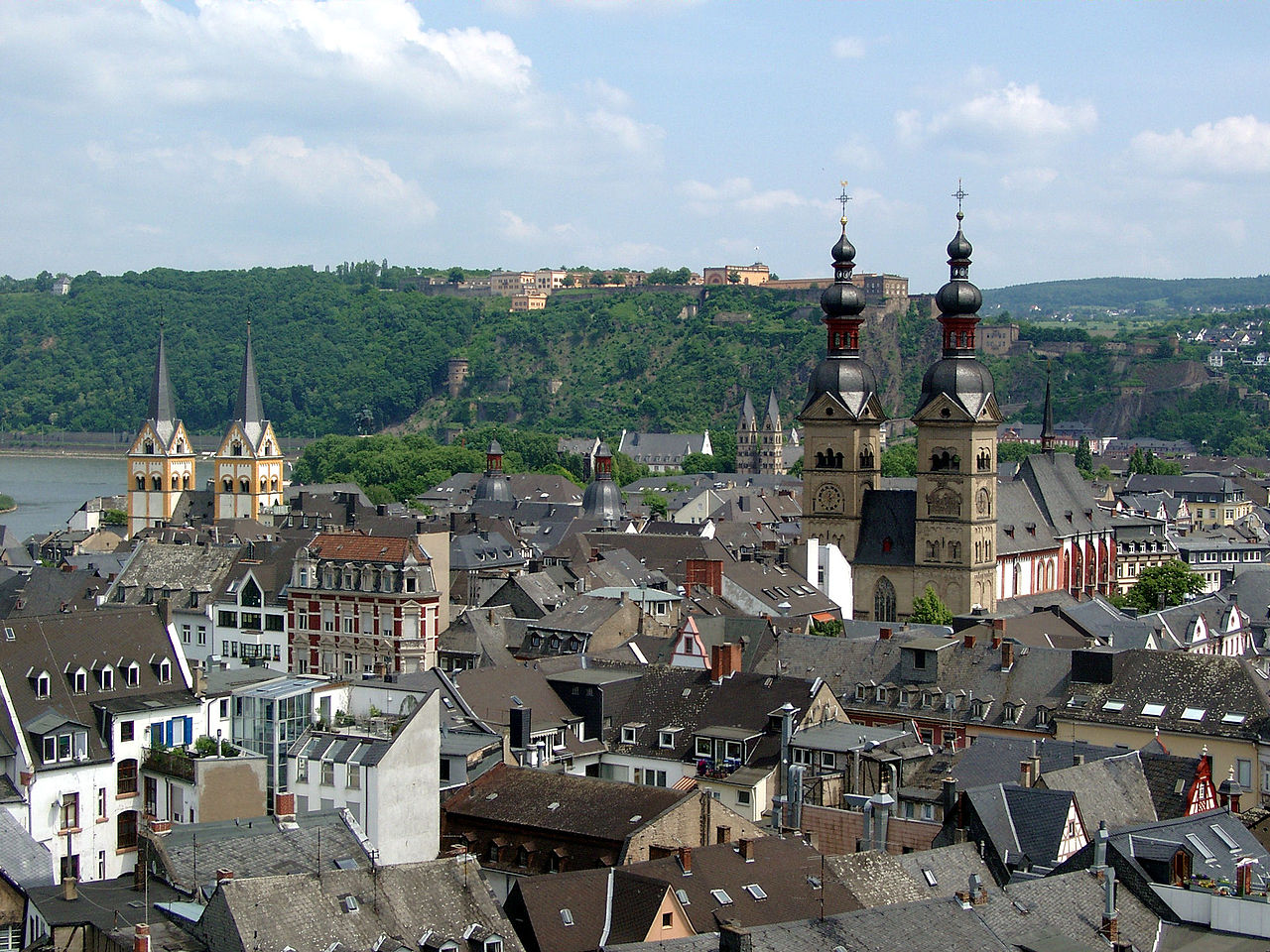
Rheinland-Pfalz
8. Niederfell to Koblenz
Easy
4h30
18,1km
+305m
-315m
Step
Embed this item to access it offline
On the right bank of the Moselle a beautiful viewpoint on the wine hillsides on the left bank of the river.
In Niederfell you reach La Moselle Strasse B49, be careful and vigilant on the cycle path, the landscape should not distract you.
In Niederfell you reach La Moselle Strasse B49, be careful and vigilant on the cycle path, the landscape should not distract you.
6 points of interest
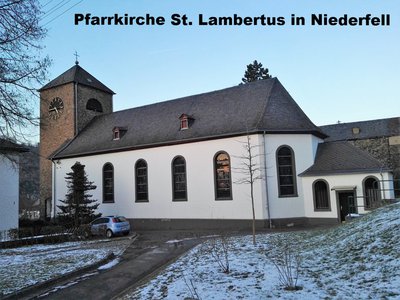
Église St. Lambertue à Niederfell - Pfarreiengemeinschaft Untermosel-Hunsrück TouristChurch St. Lambertus in Niederfell
The parish church of St. Lambertus was built in 1792 with a ridge turret and enlarged in 1871 and 1872. The tower dates from 1955 and the church is dedicated to St. Lambertus, bishop and martyr, 7th/8th century. The church is under monumental protection.
Worth seeing: the group of baroque altars from 1773, consisting of a high altar and two side altars, from the former church of the Mariarod monastery. They were brought to Niederfell by the French in 1795 when the monastery was destroyed by the citizens of Niederfell with ox carts.
Further information: St. Lambertus parish in Niederfell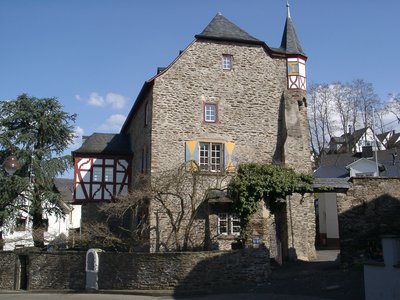
Maison du château de Heesenburg près de l'église à Bieblich - Wikimedia Commons Klaus Graf HistoricalCastle in Biedlich
In Biedlich, near the church, there is an old castle house with a remarkable hipped roof and a double row of dormer windows - the Heesenburg. It dates from the 13th century and belonged to the family of Koblenz von der Arken. In 1514 Marsilius von Arken sold the estate to the Muhl von Ulmen family. Baron Johann Philipp Ernst von und zu der Hees inherited the castle in 1762. The east side has a one-storey half-timbered building with a dwarf gable, while the southwest corner has one of the four original oriels, which were reconstructed more recently as an octagonal half-timbered structure.
More info at: Wikipedia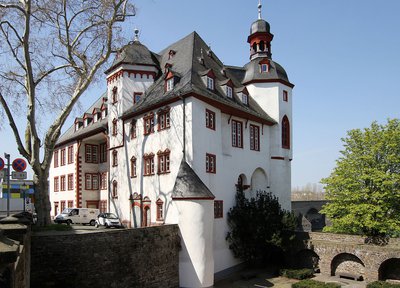
Le vieux chateau (der alte Burg) - Wikimedia Commons HOWI Horsch Willy CulturalDer Alte Burg in Koblenz
The Old Castle of Koblenz is the former castle of the Elector of Koblenz from the 13th century. Today it houses the municipal archives of Koblenz. Since 2002, it has been a UNESCO World Heritage Site.
Wikipedia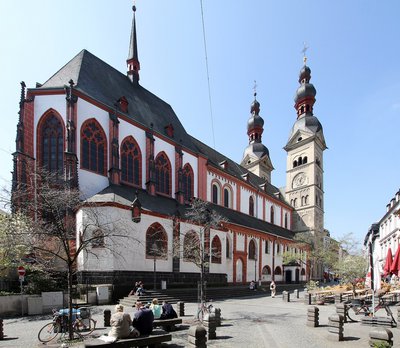
Église Notre-Dame à Coblence (Liebfrauenkirche) - Wikimedia Commons Horsch, Willy TouristChurch of Our Lady in Koblenz
The Church of Our Lady (Liebfrauenkirche) is a Catholic church in the centre of Koblenz' Old Town. Together with the two other Romanesque churches, the former collegiate churches St. Kastor and St. Florin, it dominates the silhouette of the old town. The beginnings of the church, which is located at the highest point of the Old Town, date back to the 5th century. From the late Middle Ages to the French Revolution, it was the main parish church in Koblenz. It bears the patronage of Mary, the mother of Jesus, and is a major work of medieval sacred architecture on the Middle Rhine.
An earlier building to the Liebfrauenkirche dating from the 5th century is a hall from the time of Emperor Valentinian I (364-375). Within the walls of this Roman building, the Franks, who came to Koblenz at that time, established a Christian place of worship. Using the foundations, this church underwent several alterations and extensions.
Around 1180 a Romanesque church was built on the site of the Roman building. In the 15th and 16th centuries the Gothic edifice was extensively altered. In 1694 the bell towers were rebuilt. The bombings of 1944 severely damaged the building.
More info: Wikipedia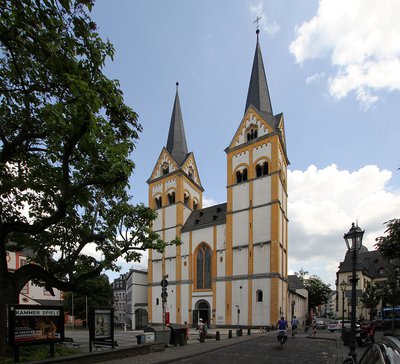
Église protestante Saint-Florin à Coblence - Wikimedia Commons Horsch, Willy TouristSt. Florin's Church in Koblenz
The Florinskirche is a protestant church in the old town of Koblenz. Built around 1100, the church building, which dominates the skyline of the city, belonged to the canonical monastery of St. Florin, which was secularized in 1802. Later, in 1820, it became the first church building in Koblenz to be consecrated as a Protestant church in the Rhineland. The early medieval church building is an excellent example of sacred Romanesque architecture on the Middle Rhine.
On this 6th century site there was a royal chapel dedicated to the Virgin Mary. At the beginning of the 10th century, after the transfer of Florin's relics from Remüs (Switzerland), the church was consecrated to St. Florin.
Around 1100 a new Romanesque church was built and in the 14th century the Romanesque apse of the church was replaced by a Gothic apse. In the years 1582 to 1614 the vaulting of the eastern nave followed. At the beginning of the 17th century, the bell towers were renovated but in 1791 lightning and fires damaged the bell towers, necessitating the reconstruction of their upper parts. The pointed roofs date from the end of the 19th century.
In 1794 French revolutionary troops occupied Koblenz during the first coalition war. The Abbey of Saint-Florin was secularised by the French in 1802 and thus suppressed. Subsequently, the church building was used as a military storehouse.
King Frederick William III transferred the building to the Protestant military and civil community in 1818.
Further information : Wikipedia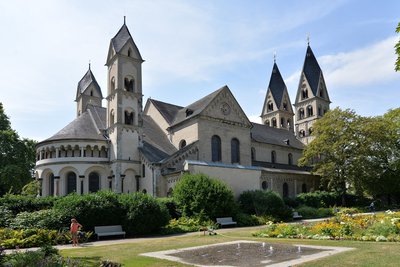
Basilique Saint-Castor à Coblence - Wikimedia Commons Calips TouristSt. Castor's Basilica in Koblenz
The Church of St. Kastor (St. Kastor or Kastorkirche in German) is the oldest church in Koblenz. Dedicated to Castor of Karden, it is situated behind the Deutsches Eck. On the square in front of the basilica is the Beaver Fountain from the Napoleonic era.
The confluence of the Moselle and the Rhine has been a historical site since Gallo-Roman times. Several treaties were signed at this location, including the Treaty of Verdun in 843 and the Peace of Koblenz in 860.
In the 9th century the basilica replaced a Gallo-Roman temple, this first church occupies the surface of the current nave. Damaged in the 12th century, it was restored in the 13th century.
Between 1496 and 1499, the basilica underwent the last major alterations, with the change of the ceiling of the nave, which became a ribbed Gothic vault. When the French invaded the region in 1802, they secularised most of the abbeys, such as the church of Saint-Castor, which had been a collegiate monastery until then, and became a simple parish church.
Heavily damaged by the bombings of 1944, it was restored during the second half of the 20th century. The parish church was elevated to the rank of Basilica in 1991.
St. Castor of Karden (5th century): Probably originally from Aquitaine, Castor became a disciple of Maximin of Trier who ordained him a priest. He settles in Treis-Karden, perhaps as a hermit. In the company of St. Potentinus, an Aquitanian like himself, he may have founded a monastic community;
In 837, Bishop Hetton of Trier had his relics transferred to the Basilica of St. Castor in Koblenz, the city of which he became patron saint.
More info: Wikipedia
Description
From the church in Niederfell, right Lennigstrasse, left then right Kammerstrasse, left Engelstrasse, right on Moselstrasse B 49
- After 2700 meters in Dieblich, turn right in the direction of the city center Farhstrasse K 68, Markplatz, Hauptstrasse, at the exit of the city stay on your right to join B 411,
- Pass under the A 61 motorway, turn right onto B 49
- After the road bridge over the Moselle (Kurth-Schumacher-Brücke), turn left onto the Moselle riverside road
- After the Balduinbrücke bridge, take the pedestrian path on the right after the castle, left Burgstrasse, straight ahead, Florinmarkt, Auf der Danne, Am Alten Hospital you arrive at Kastorf in front of St. Castor's Basilica.
- Departure : Saint-Lambertus Church, Lambertus Weg, 56332 Niederfell
- Arrival : Basilica of St. Castor, Kastorhof 4, 56068 Kobenz
- Towns crossed : Rheinland-Pfalz
Altimetric profile
Transport
Report a problem or an error
If you have found an error on this page or if you have noticed any problems during your hike, please report them to us here:






